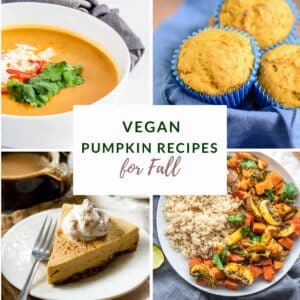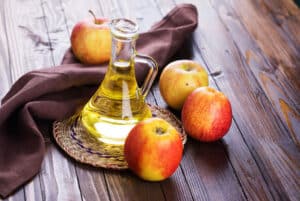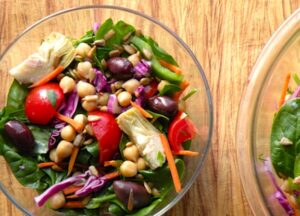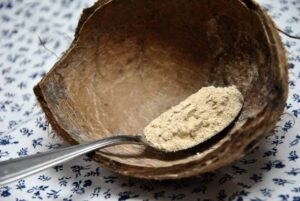We hear more and more about incorporating fiber in our diets. It's not difficult to get plenty of fiber in a whole-foods plant-based diet (AKA vegan). But what exactly is fiber? Fiber is roughage that is too complex for the body to break down. It is found in plant foods and can't be digested, which is what makes it so valuable.
The benefits of fiber consumption are many:
- It cleanses the system.
- By keeping the arteries clean, it lowers cholesterol.
- Blood pressure is often reduced.
- Insulin levels are regulated.
- It may delay or reduce the risk of developing Type 2 diabetes, diverticulitis, IBS, hemorrhoids and phlebitis in the legs.
Here is where the irony begins…
Patients suffering from constipation are encouraged to consume a lot of dietary fiber (non-digestible carbohydrates and lignin from plants) because it acts as a mild laxative and promotes bowel evacuation. A “mild laxative” is the last thing someone with diarrhea needs, right? Wrong! It is also recommended that IBS patients go on a high-fiber diet.
So how much is “enough” fiber?
The daily recommendation is 25 to 35 grams of combined soluble fiber (dissolves in water) and insoluble fiber (“roughage” that does not dissolve in water). Peas, beans and apples contain soluble fiber, which slows digestion and helps the body absorb nutrients from food. Flax seeds and nuts provide insoluble fiber, which helps foods pass through the stomach and intestines and adds bulk to the stool. It may also help control weight because it makes you feel full sooner. The total grams of fiber you should ingest depends on your system’s sensitivity.
Just a warning: A high-fiber diet causes gas because the carbohydrates in high-fiber foods cannot be completely digested in the stomach and small intestine. It is best to increase the amount of fiber consumed slowly so your body can get used to it gradually. It is vital that, as fiber is increased in the diet, so is the consumption of water.
Where do you find fiber?
Fiber is found in vegetable gums (konjac gum, gum Arabic, carrageenan, guar gum, locust bean gum, pectin vegetable gums, xanthan gum). It is also found in nature, in the foods we harvest from the ground. The following list shows some of the foods that are high in fiber:
- 1 oz. dry almonds (3g)
- 1 oz. roasted pumpkin seeds (10.2g)
- 1 oz. sunflower seeds (4g)
- 1 unpeeled medium apple (3.7g)
- 1 unpeeled pear (4.5g)
- 1 kiwi (5g)
- 4 oz. dried, sulfured apricots (8.8g)
- 4 oz. dried figs (10.5g)
- 10 dried prunes (6.1g)
- 1 cup raspberries (9g)
- ¾ cup blackberries (7g)
- ½ cup baked beans (7g)
- ½ cup chick peas (7g)
- 1 cup boiled lentils (15.6g)
- ½ cup canned lima beans (5.8g)
- ½ cup navy beans (6.7g)
- ½ cup pinto refried beans (11g)
- 1 corn on the cob (5.9g)
- 1 cup white corn (11.2g)
- 3 ½ cups air-popped popcorn (4.5g)
- 2 oz. corn pasta, cooked (7.9g)
- ½ cup frozen peas, cooked (4.2g)
You may eat 50 stalks of celery each day to get your recommended amount of fiber… or you may prefer to incorporate the suggestions below:
Add nuts and seeds (sesame seeds, pumpkin seeds, sunflower seeds) to salads and casseroles, sprinkle over vegetables, and add to a veggie stir-fry. Or sprinkle them with seasonings, then roast them slowly in the oven for a healthy snack.
Add cooked dried beans and shredded carrots to everything… from salads, to soups, to casseroles, to rice. Cooking vegetables does not change the fiber content. Eating dried beans four times a week has been shown to reduce the risk of colon cancer and heart disease.
Eat plenty of fruits, especially citrus fruits, berries, prunes, figs or apricots.
Keeping the skins on fruits (and vegetables) will add a small amount of extra fiber, but the skins are the part that are most exposed to pesticides, so unless you are buying organic fruits and vegetables, you may be better off peeling them first. If you scrub the skin of the vegetables well, you benefit from leaving the skins on potatoes and zucchini.
Add shredded zucchini to breads, muffins, stir-fries, and even scrambled eggs.
Add shredded cabbage and peas to salads, soups, wraps, and stir-fried veggies.
Use brown rice or quinoa in place white rice.
Snack on popcorn. (Air-popped is the healthiest.)
Sprinkle raisins on salads, puddings, canned fruit, baked apples, sweet potatoes, cereal, or just eat plain as a snack.
Add shredded apples to pancake batters, quick breads, and yam dishes. Serve a baked apple for dessert instead of cookies.
Eat a fresh apple, apricot, prune or orange instead of drinking the apple, apricot, prune or orange juice.
Add dried cranberries to cereal, quick breads and muffins, cookie batter, yam dishes, and salads. Make up a bowl of nuts, raisins and dried cranberries for snacking.
Incorporate fruits with edible seeds (raspberries, blackberries) into your cereal, salads and desserts.
Use flaxseed — lots of it! Flaxseed is the miracle fiber because it has very little taste of its own, which means it will not alter the taste of the foods you are preparing. It comes in three basic forms: whole seed, flour, and oil. The whole seed is the healthiest, but the seeds should be crushed slightly before using. Add the crushed seeds to cereal, breads and muffins, cookies, wraps, casseroles, crumb toppings… almost everything.
The following is a sample menu of a high-fiber diet for one day:
Breakfast: ½ grapefruit, ¾ cup cereal topped with raisins and almonds, ½ cup nondairy milk, 2 slices toast made with flaxseed and/or other seeds and nuts, 2 Tbsp. raspberry or blackberry preserves.
Lunch: 1 cup vegetable soup (made with added cabbage, carrots and flaxseed), taco wrap (see recipe below), 1 apple with skin.
Dinner: Garden salad made with 1 cup spinach, 2 Tbsp. peas, ¼ cup bean sprouts, 2 Tbsp. diced cucumber, and 1 Tbsp. sliced green onion (mix 1 Tbsp. flaxseed into the salad dressing), Vegetable Ragout (see recipe below), ½ cup frozen nondairy dessert topped with ½ cup fresh strawberries.
The tips above are from Connie’s book, Wheat-free Gluten-free Recipes for Special Diets.
- For more tips on plant-based nutrition, make sure to browse VegKitchen’s Nutrition page.
- For lots more features on healthy lifestyle, please explore VegKitchen’s Healthy Vegan Kitchen page.






Joseph Howarth says
I am now suffering to a disease called hemorrhoid. Hemorrhoids are swollen veins located around the anus or in the lower rectum and you can only get this if you have insufficient fiber in your body. If you experience chronic diarrhea, that is a sign that you need higher fiber in your body. My doctor recommended me some medications and to have a healthy lifestyle like eating a lot of fibers to cure hemorrhoid because fiber can\'t just avoid diseases but also helps to treat it.